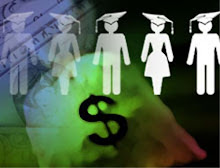In my theory post, I mentioned how lower level education and the No Child Left Behind Act affect students abilities to get into and succeed in college. I also mentioned another factor that affects higher level education: family background. Many low-income and minority Americans are finding it harder to go to college because of the rising inequality and polarization of society. A greater fraction of young Americans are graduating from college, but at the same time a greater fraction is also dropping out of high school. More children are being born into disadvantaged environments and are receiving relatively less stimulation and resources to promote child development than those born into more advantaged families. Without the resources and backgrounds of more advantaged children, these kids are never able to truly compete on a level playing field and are always behind their more knowledgeable peers in school and in the basic survival skills of life.
There are some options being researched to fix this situation. Three major advocates of of poor children are James J. Heckman, Susan B. Neuman and Geoffrey Canada. Heckman developed the theory that poverty is a problem of skills and poor children grow into poor adults because they are never able, either at home or at school, to acquire the abilities and resources they need to compete in a high-tech service-driven economy .Heckman stresses that these skills are both cognitive (the ability to read and compute) and noncognitive (the ability to stick to a schedule, to delay gratification and to shake off disappointments). According to Heckman if intervention into poor childrens lives is started in infancy and continued through childhood, the skill gap between poor and middle class will be diminished.
That is where the work of Newman and Canada come into play. Neuman has spent several years crisscrossing the nation, examining and analyzing programs intended to improve the lives of disadvantaged children and is publishing a book in November called “Changing the Odds for Children at Risk," that describes nine nonschool interventions. She includes the Nurse-Family Partnership, which sends trained nurses to visit and counsel poor mothers during and after their pregnancies; Early Head Start, a federal program, considerably more ambitious than Head Start itself, that offers low-income families parental support, medical care and day-care centers during the first three years of the lives of their children; Avance, a nine-month language-enrichment program for Spanish-speaking parents, mostly immigrants from Mexico, that operates in Texas and Los Angeles; and Bright Beginnings, a pre-K program in the Charlotte-Mecklenburg school district in North Carolina that enrolls 4-year-olds who score the lowest on a screening test of cognitive ability and manages to bring most of them up to grade level by the first day of kindergarten. These programs all yield positive results but are scattered throughout the country and only influence the first few years of a child's life meaning once students are takne out of the programs the effects begin to diminish.
Canada has designed an agency called the Harlem Children’s Zone that offers integrated social and educational services for thousands of children at once. His program begins with Baby College, a nine-week parenting program that encourages parents to choose alternatives to corporal punishment and to read and talk more with their children. Under his organization students progress through an all-day prekindergarten and then through a charter school,where they have continuous access to community supports like family counseling, after-school tutoring and a health clinic, all designed to mimic the often-invisible cocoon of support and nurturance that follows middle-class and upper-middle-class kids through their childhoods. The goal, in the end, is to produce children with the abilities and the character to survive adolescence in a high-poverty neighborhood, to make it to college and to graduate. So far his results have been uplifting. When the charter schools’ inaugural kindergarten class reached third grade and took their first New York state achievement tests: 68 percent of the students passed the reading test, which beat the New York City average and came within two percentage points of the state average, and 97 percent of them passed the math test, well above both the city and state average.
My point is that unless America does something to help it's poor children, the discrepancy between poor and middle class will continue to grow. How is this applied to higher level education? Colleges are always trying to create more diversity within their campus's by increasing the number of poor and minority students who attend, but if Americas poor children are not well educated or don't have the necessary skills to succeed then that makes college diversity harder to obtain. Not only that but it creates a nearly impossible barrier for poor students to get ahead in life. With Americas growing emphasis on college education, we should look into these different programs and help our poor children obtain the levels of education received by middle and upper class kids. Obama has looked into at the reforms I mentioned above and while they could be expensive, they will also allow poor kids to have the same opportunities as everyone else when they graduate. If America is really about freedom and equality, then these programs should definitely be taken into consideration because unless they are able to receive the benefits that middle and upper class children have from their parents and schools, there is not equality or freedom for poor kids in America.
The Weirdest Medical Cases of 2025
36 minutes ago

No comments:
Post a Comment